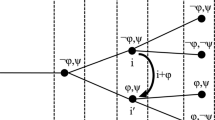Abstract
One of an information system's important roles is to provide a representation of a Universe of Discourse, which reflects its structure and behaviour. An equally important function of the system is to support communication within an organisation by structuring and coordinating the actions performed by the organisation's agents. In many systems development methods, these different roles that an information system assumes are not explicitly separated. Representation techniques appropriate for one role are uncritically applied to another. In this paper, we propose a unifying framework based on speech act theory, which reconciliates the representation and communication roles of information systems. In particular, we show how communication can be modelled by means of discourses, which are viewed as sequences of events.
Chapter PDF
Similar content being viewed by others
Keywords
These keywords were added by machine and not by the authors. This process is experimental and the keywords may be updated as the learning algorithm improves.
References
E. Auramäki, E. Lehtinen and K. Lyytinen, “A Speech-Act Based Office Modelling Approach”, ACM Transactions on Office Information Systems, vol. 6, no. 2, pp. 126–152, 1988.
C. Batini, S. Ceri and S. Navathe, Conceptual Database Design, Benjamin/Cummings, 1991.
J. A. Bubenko Jr., “Problems and Unclear Issues with Hierarchical Business Activity and Data Flow Modelling”, SYSLAB Working Paper no. 134, The Royal Institute of Technology and the University of Stockholm, 1988.
E. Coad and D. Yourdon, Object Oriented Analysis and Design, Addison-Wesley, 1990.
J. Dietz, “Modelling Communication in Organizations”, in Linguistic Instruments in Knowledge Engineering, Ed. R. v. d. Riet, pp. 131–142, Elsevier Science Publishers, 1992.
F. Flores, M. Graves, B. Hartfield and T. Winograd, “Computer Systems and the Design of Organizational Interaction”, ACM Transactions on Office Information Systems, vol. 6, no. 2, pp. 153–172, 1988.
C. Gane and T. Sarson, Structured Systems Analysis: Tools ans Techniques, Prentice-Hall, 1979.
Peter Holm, Swedish Institute of Systems Development, Personal Communication
C. H. Kung, “Conceptual Modeling in the Context of Software Development”, IEEE Transactions on Software Engineering, vol. 15, no. 10, pp. 1176ff., 1989.
R. Medina-Mora et.al., “The Action Workflow Approach to Workflow management Technology”, 4th CSCW Conference, Toronto, 1989.
S. Naqvi and S. Tsur, A Logical Language for Data and Knowledge Bases, Computer Science Press, 1989.
A. Opdahl and G. Sindre, “Concepts for Real-World Modelling, 5th International Conference on Advanced Information Systems Engineering, Ed. C. Rolland, Paris, Springer, 1993.
J. Searle, Speech Acts — An Essay in the Philosophy of Language, Cambrudge University Press, 1969.
J. Searle and D. Vanderveken, Foundations of Illocutionary Logic, Cambridge University Press, 1986.
Author information
Authors and Affiliations
Editor information
Rights and permissions
Copyright information
© 1994 Springer-Verlag Berlin Heidelberg
About this paper
Cite this paper
Johannesson, P. (1994). Representation and communication in information systems — A speech act based approach. In: Wijers, G., Brinkkemper, S., Wasserman, T. (eds) Advanced Information Systems Engineering. CAiSE 1994. Lecture Notes in Computer Science, vol 811. Springer, Berlin, Heidelberg. https://doi.org/10.1007/3-540-58113-8_171
Download citation
DOI: https://doi.org/10.1007/3-540-58113-8_171
Published:
Publisher Name: Springer, Berlin, Heidelberg
Print ISBN: 978-3-540-58113-0
Online ISBN: 978-3-540-48459-2
eBook Packages: Springer Book Archive




